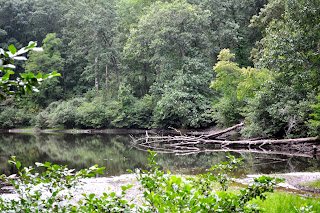Yesterday I hiked the Lake Trail at Clear Creek Metro Park
with the aim of doing a bit of botanizing. It was 65 degrees and cloudy—just
heavenly for me. The trail is only 1 mile and the stated time is 28 minutes,
but I was shooting and botanizing so I spent well over an hour there.
It was my first time on the trail. I was glad of my walking
stick at the end, for the trail up from the lake is very steep with high
‘steps’ that even my very long legs had trouble negotiating. Apart from the
very steep gradient in the last leg of the trail, it is a very pleasant and easy
walk.
I don’t know that I got any great photos. I only carried my
18-55 mm lens and no tripod. It is very hard to deal with deep shade. For close-ups I
sometimes take one with and one without flash.
As always, I never leave the trail and I never damage or
pick any plant. I also avoid touching rocks and logs for fear of damaging the
lichens and mosses that thrive.
The dense undergrowth in parts of the trail makes it
difficult to isolate a botanical specimen for a photo. We have had rain, once
torrential in the past week, but the three drought months before took their
toll. Many plants are dried and damaged. So my walk was more of a census: I took
many photos that will remind me sequentially where I found various plants. The lake was drought-shrunken,
receding far from the observation deck. The 'shore' visible in the photo at the top of the page should be under water.
Following the fern course I took July 30 to August 2, 2012 I have been especially looking for ferns and fern allies. There were enormous Ostrich Ferns along the nearly dry creek bed, but they were far off-trail and largely obscured by shrubs. There was an area of at least an acre where New York Ferns lay mostly brown and shriveled from drought and heat. I documented this all, but the photos are for file only at this point. Maidenhair Ferns were dark and damaged.
Following the fern course I took July 30 to August 2, 2012 I have been especially looking for ferns and fern allies. There were enormous Ostrich Ferns along the nearly dry creek bed, but they were far off-trail and largely obscured by shrubs. There was an area of at least an acre where New York Ferns lay mostly brown and shriveled from drought and heat. I documented this all, but the photos are for file only at this point. Maidenhair Ferns were dark and damaged.
I did find some handsome fungus and lichens.
Peronidulus conchifer sun. Trametes conchifer, Lake Trail, Clear Creek Metro Park, Rockbridge, Hocking Co., Ohio. These funghi colonize fallen trees, helping to recycle nutrients.
Common Greenshield Lichen (Flavioparmelia caperata), Lake Trail, Clear Creek Metro Park, Rockbridge, Hocking Co., Ohio
On the way out I stopped to photograph a fine stand of Tall
Scouring Rush (Equisetum hyemale). Equisetums also known as horsetails are
officially considered ferns now. They contain silica particles that make them
useful for scouring pots and pans where they grow at waterside. They spread
rapidly by rhizomes, and eventually crowd out other vegetation. They should
never be planted in a home garden!
Other species identified during my walk: Three-lobed Coneflower (Rudbeckia trilobum), Canada Thistle (Cirsium arvense)*, Christmas Fern (Polystichum acrostichoides), Maidenhair Spleenwort (Asplenium trichomanes), Resurrection Fern (Pleopeltis polypodiodes)**, Rattlesnake Fern (Botrychium virginianum), Hairy Cap Moss (Polytrichum ohioense), Partridge Berry (Mitchella repens), New York Fern (Thelypteris novaboracensis), Ostrich Fern (Matteucia struthiopteris), Maidenfair Fern (Adiantum pedatum), Joe Pye Weed (Eupatorium purpurea), Ironweed (Vernonia gigantea), Seersucker Sedge (Carex plantaginea), Pincushion Moss (Leucobryum albidum), Rhododendron maximum, Queen Anne's Lace (Daucus carota)*
The photos shown here and photos of some of the species listed above can be seen in better resolution at http://www.flickr.com/photos/vbergesen/
*An invasive European
**This will be the subject of a future blog.
*An invasive European
**This will be the subject of a future blog.





No comments:
Post a Comment